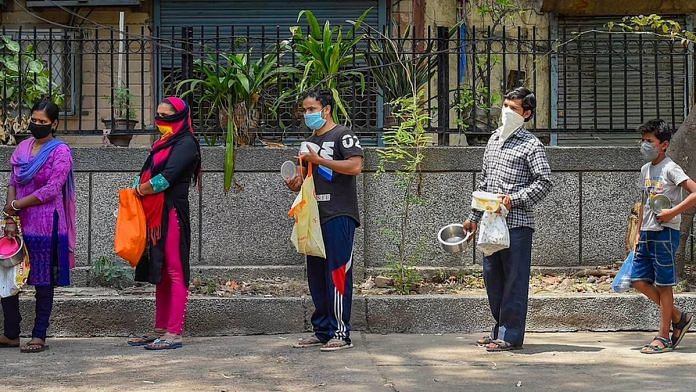New Delhi: The Centre’s policy of providing free food grains to 80 crore households during the pandemic prevented India from slipping into extreme poverty as it withstood one of the biggest income shocks globally, a working paper by the International Monetary Fund said. It has also suggested a revision in India’s poverty line demarcation, as it progresses into the category of a middle income country.
The free food grains was distributed as part of the Pradhan Mantri Garib Kalyan Anna Yojana (PMGKAY), launched in March 2020, under which the Centre provided five kilograms of food grains every month to each beneficiary family for free. This was in addition to the normal quota distributed under the National Food Security Act (NFSA), which is provided at a subsidised rate of Rs 2-3 per kg.
Last month, the Union Cabinet extended the PMGKAY programme till September 2022, at an additional estimated cost of Rs 80,000 to the exchequer.
“The program provided insurance to the poor and prevented an increase in the prevalence of extreme poverty in India. This illustrates the robustness of India’s social safety architecture as it withstood one of the world’s biggest exogenous income shocks,” stated the IMF paper, released on 5 April.
Extreme poverty is defined by the United Nations as “a condition characterised by severe deprivation of basic human needs, including food, safe drinking water, sanitation facilities, health, shelter, education and information. It depends not only on income, but also on access to services”.
The IMF paper added that it is a reasonable assumption that the free food grain prevented increase in prevalence of extreme poverty in India, given that households could always sell the subsidised food grains in the open market.
The paper has been authored by Surjit Bhalla, executive director at the IMF for India, Bangladesh, Bhutan and Sri Lanka and former part-time member of the Prime Minister’s Economic Advisory Council (PMEAC), New York-based economist Karan Bhasin, and former chief economic adviser Arvind Virmani.
According to the authors, the extreme poverty in India was as low as 0.8 per cent of the population in the pre-pandemic year of 2019, and food transfers were instrumental in ensuring that it remained at that low level even in the pandemic year of 2020.
Also read: Code red on malnutrition: Why half the kids in 3 poorest UP districts are stunted, many ‘wasted’
Need for a new official poverty line
The working paper also stated that India should revise its poverty line demarcation to an income of $3.2 per person per day, from the current $1.9 per person per day, as it moves from being a low-income country to a middle-income country.
“The low level of extreme poverty — around 0.8 per cent (of population) in both 2019 (0.76 per cent) and 2020 (0.86 per cent) — is suggestive of the need for the official poverty line to now be $3.2 in purchasing power parity (PPP),” it said.
The PPP value of a dollar is different from the market value. According to data with the Organisation for Economic Co-operation and Development, a dollar in PPP terms is currently valued at Rs 23.30, against Rs 15.55 in 2011.
Going by the IMF working paper’s estimate of the country’s poverty line, India can reasonably claim that before the pandemic it was on the verge of eliminating extreme poverty.
The data used by the authors in the working paper include the consumer spending survey of 2011-12 by the National Statistical Office for its calculations, as the latest survey of 2017-18 was junked by the government over alleged data quality issues. The poverty figures have been derived by using the real gross state domestic product (GSDP) growth rate. To calculate the poverty figures beyond 2011-12, the authors have used the NSO’s data on private final consumption spending.
(Edited by Poulomi Banerjee)
Also read: India is less poor & more fed, but nearly as unequal as last year, Niti Aayog report shows



